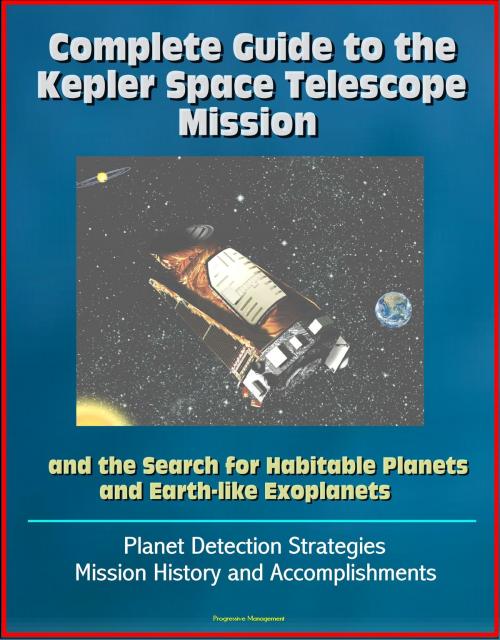Complete Guide to the Kepler Space Telescope Mission and the Search for Habitable Planets and Earth-like Exoplanets: Planet Detection Strategies, Mission History and Accomplishments
Nonfiction, Science & Nature, Science, Physics, Astronomy, Astrophysics & Space Science| Author: | Progressive Management | ISBN: | 9781301293070 |
| Publisher: | Progressive Management | Publication: | May 23, 2013 |
| Imprint: | Smashwords Edition | Language: | English |
| Author: | Progressive Management |
| ISBN: | 9781301293070 |
| Publisher: | Progressive Management |
| Publication: | May 23, 2013 |
| Imprint: | Smashwords Edition |
| Language: | English |
This is a comprehensive guide to the search for planets outside our solar system (called exoplanets), particularly Earth-like habitable worlds, and the work of the pioneering NASA planet-finding space telescope, Kepler. In addition to detailed coverage of the Kepler spacecraft and its discoveries, there is coverage of the ongoing worldwide search for exoplanets.
The centuries-old quest for other worlds like our Earth has been rejuvenated by the intense excitement and popular interest surrounding the discovery of hundreds of planets orbiting other stars. There is now clear evidence for substantial numbers of three types of exoplanets; gas giants, hot-super-Earths in short period orbits, and ice giants. The challenge now is to find terrestrial planets (i.e., those one half to twice the size of the Earth), especially those in the habitable zone of their stars where liquid water and possibly life might exist. The Kepler Mission is specifically designed to survey a portion of our region of the Milky Way galaxy to discover dozens of Earth-size planets in or near the habitable zone and determine how many of the billions of stars in our galaxy have such planets. Results from this mission will allow us to place our solar system within the continuum of planetary systems in the Galaxy.
Kepler uses the transit method of detecting extrasolar planets. When a planet crosses in front of its star as viewed by an observer, the event is called a transit. Transits by terrestrial planets produce a small change in a star's brightness of about 1/10,000 (100 parts per million, ppm), lasting for 1 to 16 hours. This change must be periodic if it is caused by a planet. In addition, all transits produced by the same planet must be of the same change in brightness and last the same amount of time, thus providing a highly repeatable signal and robust detection method. Once detected, the planet's orbital size can be calculated from the period (how long it takes the planet to orbit once around the star) and the mass of the star using Kepler's Third Law of planetary motion. The size of the planet is found from the depth of the transit (how much the brightness of the star drops) and the size of the star. From the orbital size and the temperature of the star, the planet's characteristic temperature can be calculated. Knowing the temperature of a planet is key to whether or not the planet is habitable (not necessarily inhabited). Only planets with moderate temperatures are habitable for life similar to that found on Earth.
Cooperation between NASA's space-based telescopes, like the Kepler mission, and ground-based telescopes funded in part by the National Science Foundation (NSF), has enabled astronomers to expand their star gazing capabilities. Also, next year construction will begin on the new NSF funded Large Synoptic Survey Telescope in Chile. In addition to its many other capabilities, this telescope will essentially take a 10-year time lapse photo of the universe. The data collected from the telescope will help astronomers confirm the existence and types of exoplanets in our solar system. The James Webb Space Telescope will use both transit spectroscopy and direct imaging to determine the make-up of exoplanet systems in our galaxy. This is an exciting time in the fields of astronomy and astrophysics. I look forward to hearing our witnesses' perspectives on these issues.
Contents: Kepler Mission; Hearing on Exoplanet Discoveries: Have We Found Other Earths?; Kepler Press Kit; Kepler Instrument Handbook; Kepler Archive Manual.
This is a comprehensive guide to the search for planets outside our solar system (called exoplanets), particularly Earth-like habitable worlds, and the work of the pioneering NASA planet-finding space telescope, Kepler. In addition to detailed coverage of the Kepler spacecraft and its discoveries, there is coverage of the ongoing worldwide search for exoplanets.
The centuries-old quest for other worlds like our Earth has been rejuvenated by the intense excitement and popular interest surrounding the discovery of hundreds of planets orbiting other stars. There is now clear evidence for substantial numbers of three types of exoplanets; gas giants, hot-super-Earths in short period orbits, and ice giants. The challenge now is to find terrestrial planets (i.e., those one half to twice the size of the Earth), especially those in the habitable zone of their stars where liquid water and possibly life might exist. The Kepler Mission is specifically designed to survey a portion of our region of the Milky Way galaxy to discover dozens of Earth-size planets in or near the habitable zone and determine how many of the billions of stars in our galaxy have such planets. Results from this mission will allow us to place our solar system within the continuum of planetary systems in the Galaxy.
Kepler uses the transit method of detecting extrasolar planets. When a planet crosses in front of its star as viewed by an observer, the event is called a transit. Transits by terrestrial planets produce a small change in a star's brightness of about 1/10,000 (100 parts per million, ppm), lasting for 1 to 16 hours. This change must be periodic if it is caused by a planet. In addition, all transits produced by the same planet must be of the same change in brightness and last the same amount of time, thus providing a highly repeatable signal and robust detection method. Once detected, the planet's orbital size can be calculated from the period (how long it takes the planet to orbit once around the star) and the mass of the star using Kepler's Third Law of planetary motion. The size of the planet is found from the depth of the transit (how much the brightness of the star drops) and the size of the star. From the orbital size and the temperature of the star, the planet's characteristic temperature can be calculated. Knowing the temperature of a planet is key to whether or not the planet is habitable (not necessarily inhabited). Only planets with moderate temperatures are habitable for life similar to that found on Earth.
Cooperation between NASA's space-based telescopes, like the Kepler mission, and ground-based telescopes funded in part by the National Science Foundation (NSF), has enabled astronomers to expand their star gazing capabilities. Also, next year construction will begin on the new NSF funded Large Synoptic Survey Telescope in Chile. In addition to its many other capabilities, this telescope will essentially take a 10-year time lapse photo of the universe. The data collected from the telescope will help astronomers confirm the existence and types of exoplanets in our solar system. The James Webb Space Telescope will use both transit spectroscopy and direct imaging to determine the make-up of exoplanet systems in our galaxy. This is an exciting time in the fields of astronomy and astrophysics. I look forward to hearing our witnesses' perspectives on these issues.
Contents: Kepler Mission; Hearing on Exoplanet Discoveries: Have We Found Other Earths?; Kepler Press Kit; Kepler Instrument Handbook; Kepler Archive Manual.















